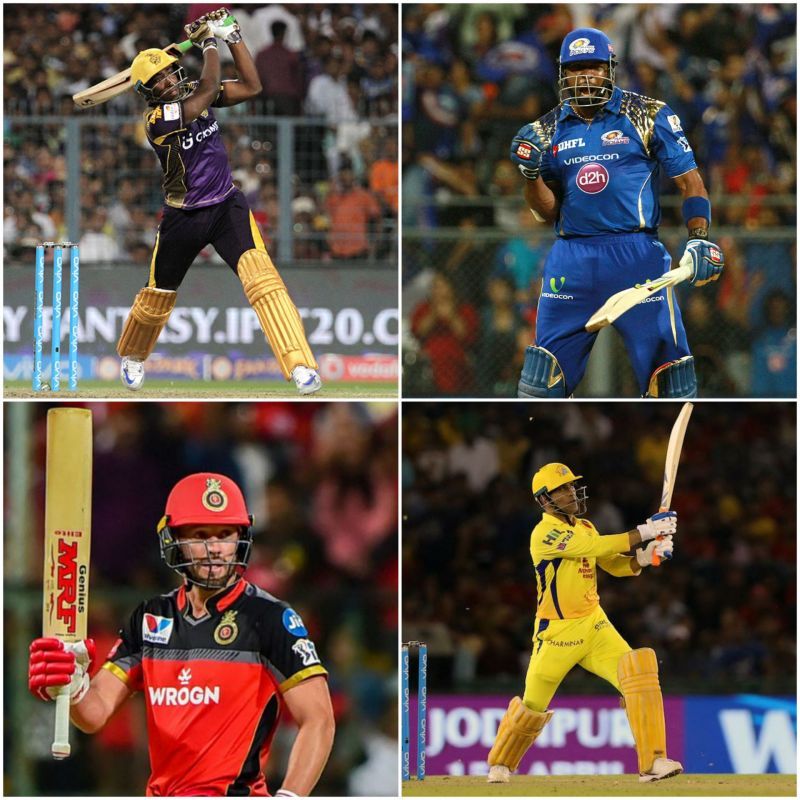
The best middle-order batsman in IPL history based on statistical analysis
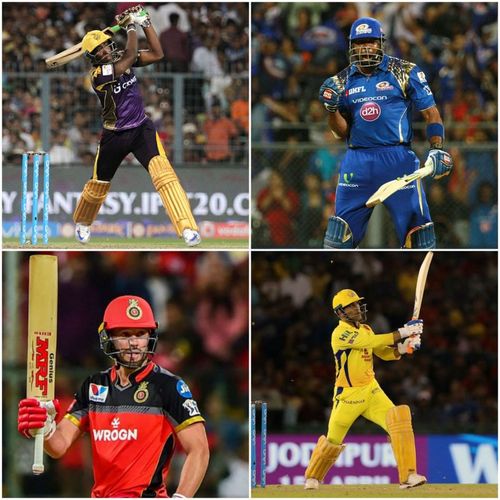
The IPL (Indian Premier League) has seen a plethora of players who have enthralled fans with bat and ball during the competition's 12 editions.
In this article, I am going to analyse seven middle-order batsmen who have graced the IPL. The analysis, which will mostly be based on statistics, is an attempt to determine the most successful middle-order batsman in the history of the lucrative T20 league.
All the stats considered in this article are for players who have batted in the middle orde, or in other words, players who have batted at number 4 to number 7 in the IPL.
Shortlisting the batsmen according to their IPL batting numbers
At the outset, let us shortlist the batsmen who will be analysed. The first criteria of analysis is said that the said batsman should have scored a minimum of 1000 runs till date while playing in the middle order in the IPL.
Another criteria for our analysis is that the player should also possess a minimum Batting Average+Strike Rate (BASRA) score of 170 and should have played at least five seasons in the cash-rich T20 league.
Based on these two criteria, we get the following seven middle order batsmen:
MS Dhoni (4244 runs)
Yusuf Pathan(2754 runs)
Kieron Pollard (2610 runs)
David Miller (1828 runs)
AB De Villiers (2209 runs)
Andre Russell (1267 runs)
Shane Watson (1092 runs).
Notable names like Rohit Sharma and Dinesh Karthik missed out due to the BASRA filter, and Rishabh Pant, despite having a phenomenal BASRA score of 199, doesn't feature because he has played only four seasons in the IPL.
The Analysis to determine the best middle-order batsman in the IPL
#1: Average and Strike Rate (BASRA) score
The first metric to analyse the batsmen is based on their Average + Strike Rate (BASRA) score.
The results are hardly surprising. MS Dhoni average of 42.44 is bolstered because of his 63 not outs while plying his trade in the middle order in the IPL. Dhoni's high average is a reflection of his penchant to remain unbeaten in most of his innings. However, on strike rate front, Dhoni's strike rate of 138.47 is the lowest among the seven considered batsmen.
In terms of average, there is daylight between MS Dhoni and the next best batsman, David Miller, who has an average of 35.15. But like the CSK captain, Miller also has a sub-par strike rate of 139.01, which is marginally higher than Dhoni's.
The duo is followed closely by AB De Villers and Andre Russell who average 34.52 and 34.24 respectively in the IPL. As their swashbuckling batting style would suggest, the big-hitting duo has the best strike rate in the list.
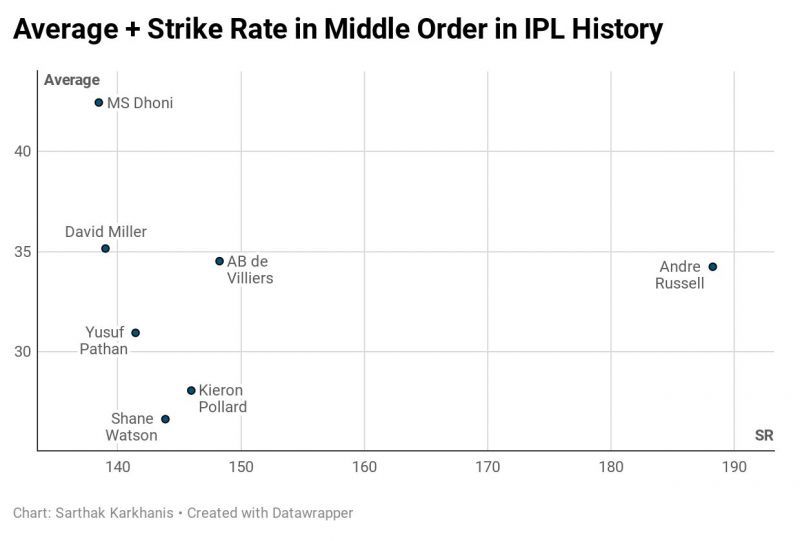
All the others have their strike rates in the range of 140-150 but Russell’s is close to 190, which is outstanding. Russel's high IPL strike rate can be attributed to the fact that mostly he comes out to bat in the later overs, which means that he has little option but to go after the bowling from the first ball.
AB De Villiers' best seasons in the IPL have come while batting at No. 3. So although his average of 34 and a strike rate of 148 are decent enough, they do not do justice to the kind of batting we have seen from the South African over the years in the IPL.
Shane Watson, however, has had only a couple of seasons where he has batted more than 10 innings in the middle order in the IPL. He has mostly been an opener in the IPL. Hence it comes as no surprise that his below-par average of 26 in the IPL doesn't quite reflect his true batting potential.
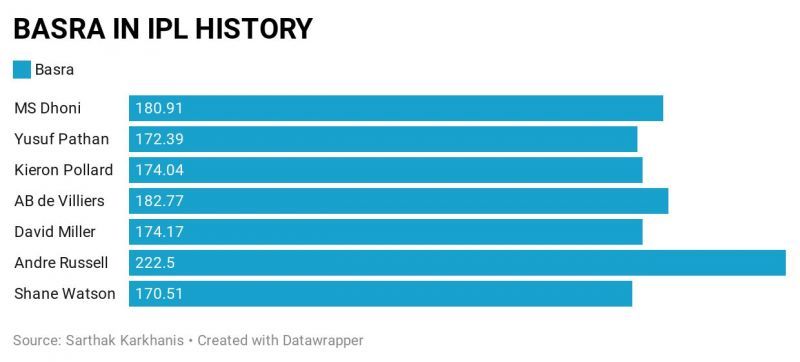
The Batting Average + Strike Rate (BASRA) is a metric that effectively determines a batsman’s ability to score runs as well as doing so at a brisk pace.
Predictably, Andre Russell is way ahead of the rest in this metric. Russel has an excellent strike rate in the IPL, with nobody even comeing close, but has a sub-par average.
Despite having a low strike rate, MS Dhoni is third in this metric due to his high average and follows AB De Villiers who has a decent average and strike rate. The rest of the batsmen are closely placed, with all of them having a BASRA score ranging between 170-175.
#2: Runs per innings (RPI) and Balls per innings (BPI) in the IPL
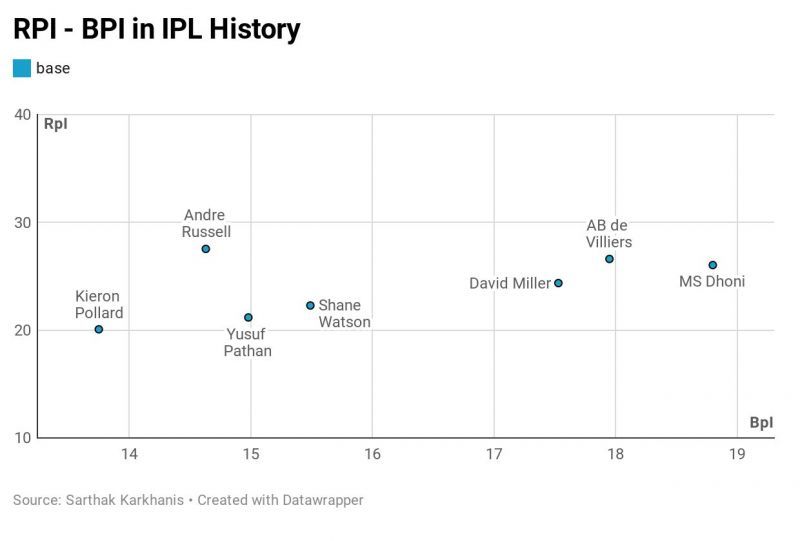
The metric of balls per innings is to analyse the length of a batsman’s stay at the crease and compare it with the number of runs they score.
Overall, there is not much that separates the seven batsmen in terms of runs per innings.
Astonishingly, Russell has the highest runs per innings score of 27.54, although he is more of a hit or miss kind of player. The Caribbean only plays around 14 balls per IPLinnings, which is the lowest of any other batsman in our list.
The biggest surprise in this metric is Kieron Pollard who has established himself as a Mumbai Indians’ and IPL legend over the years. The 32-year-old has the lowest runs per innings (20.08) and also the lowest balls per innings (13.75) in our list, which comes as a major surprise considering his big-hitting prowess.
MS Dhoni, who has been an anchor in the middle order on most occasions in the IPL, has the highest mean of balls per innings (18.8) and a decent runs per innings score of 26.04.
AB De Villiers, a destructive middle-order batsman for Royal Challengers Bangalore, has the second best runs per innings and balls per innings mean scores.
Watson, Pathan and Miller have sub-par scores in both these categories and don't quite stand-out compared Russel, Pollard, Dhoni and De Villiers.
#3: 30s to 50s conversion rate in the IPL
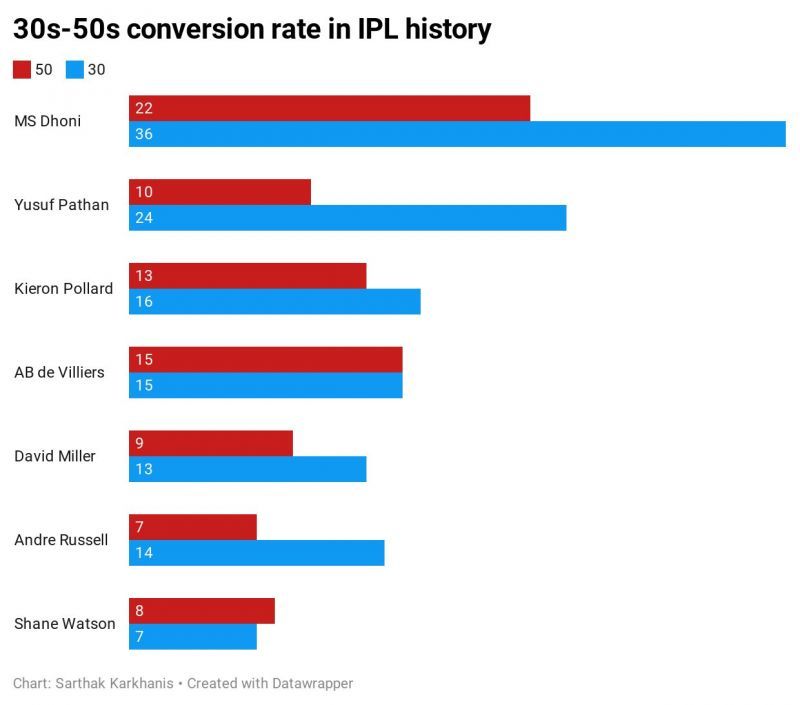
In T20 cricket, the 30s to 50s conversion is a popular metric to determine a batsman's efficacy. While 30 indicates that a batsman has got a start in the innings, 50 means that the batsman has made the most of the foundation he laid.
With 15 30+ scores in the IPL, Shane Watson has the lowest number of 30+ scores among the seven batsmen but has more 50s than 30s, which indicates that he builds on his IPL starts more often than not.
AB De Villiers has an impressive record too. With 30 50+ scores and as many 30 30+ scores for a conversion rate of 1, it reflects the kind of player he has been in the IPL.
MS Dhoni has a below-par conversion rate of 0.61 in IPL but with 58 30+ scores over the years in the middle order, he is bound to have more 30s than 50s. Also, most of the 3-time IPL winning captain's innings have come during the death overs, which explains that 19 of his 36 30+ scores are unbeaten ones.
Kieron Pollard has the 3rd best conversion rate of 0.81, which reflects the crisis-man type of batsman he has been for MI over the years. Pathan, however, is on the other end of the spectrum. He has the worst conversion rate of 0.42 while batting for KKR, RR and SRH in the IPL.
4. Runs per Non-boundary strike rate and Balls per boundary
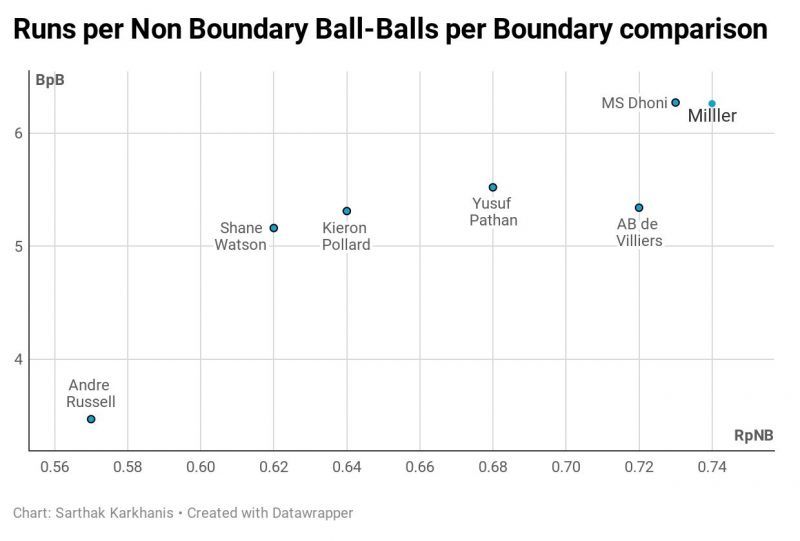
The Runs per Non-boundary balls and Balls per boundary are a measure of a batsman’s strike rotating skills and his boundary-hitting ability.
Andre Russell is the best boundary hitter in the IPL by a distance, scoring a boundary every 3.47 balls. Surprisingly, Watson has the second-best balls per boundary score of 5.1 in the IPL. However, the KKR batsman has the lowest Runs per Non-boundary score of 0.57 in the competition.
The best strike rotators in the IPL are MS Dhoni, AB De Villiers and David Miller. But the trio has the highest balls per boundary rate compared to the other players in the list.
Pollard and Pathan have sub-par results in both the categories.
Conclusion
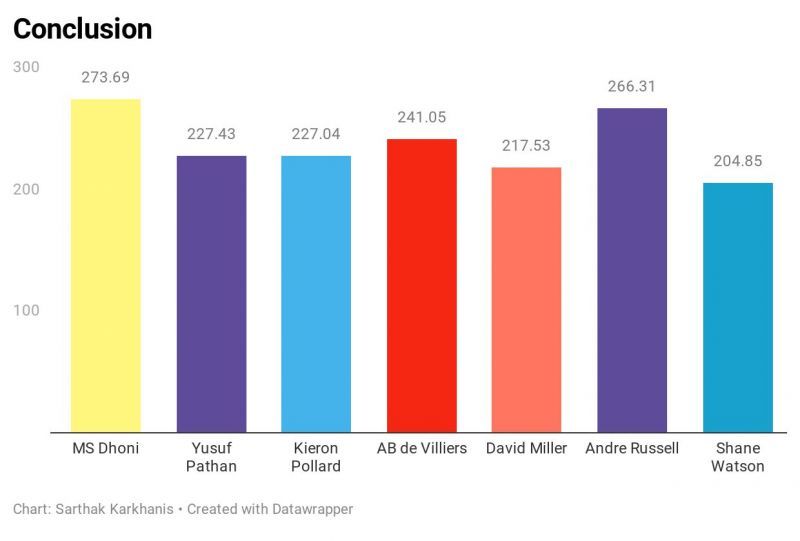
The conclusion on who is the best middle-order batsman in IPL has been done objectively based on various metrics and a batting index.
Batting Index- Summation of BASRA, Difference between RPI and BPI, Number of 30+ scores, Number of 50+ scores *2, Difference between BpB and RpNB.
The batting index shows that MS Dhoni has been the best middle-order batsman in the IPL followed closely by Andre Russell in second place while AB De Villiers takes the third spot.